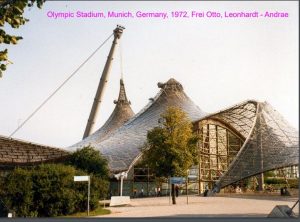Sunum – Basic Structure Elements in Architecture (Mimarlıkta Temel Yapı Elemanları)

Bir yapı tasarlarken temel yapı elemanlarının boyutlarını belirlemek için o elemanın taşıyacağı yük hakkında bilgi sahibi olmamız gerekir.Basit yapılarda bu yük dağılımları rahatça geometrik şekillerden bulunabilir.Ancak kompleks yapılarda bu hesap kapsamlı hale gelebilir.Hem mimarlar için hem de mühendisler için tasarım yaparken faydalanacağınız güzel bir kaynak.Yapılmış ekstrem yapılarla örneklendirilmiş PROF. WOLFGANG SCHUELLER ‘in sunum dosyasını aşağıdan indirebilirsiniz.
Sunumdan birkaç sayfa ;
STRUCTURE as ordering system, it functions as a spatial and dimensional
organizer besides identifying assembly or construction systems.
geometry vs. composition, dimensional coordination (grids, surface
subdivision, mathematics, etc.):
• Beijing Jian Wai SOHO Beijing, Riken Yamamoto
• Langen Foundation, Hombroich, Germany, 2004, Ando
• Buckminster Fuller geodesic dome, US Expo Montreal, 1967
• tree houses, Rotterdam, Piet Blom
• capsule tower, Tokyo, 1972, Kurokawa
• Daniel Libeskind, city edge
• bus shelter, Aachen, Germany, 1996, Peter Eisenman
• CCTV Headquarters and TVCC Building, Beijing, Rem Koolhaas
• National Swimming Center in Beijing, 2007, Arup, space frame cells
• Beijing Olympic Stadium, called the “nest”, Herzog and De Meuron, Arup Eng
• Guggenheim Museum, Bilbao, 1997, Frank Gehry
• Fisher Center, Bard College, NY, Frank Gehry
UFA Palace Dresden (German Architecture Price 1999), COOP Himmelblau
• Phare Tower, La Défense, Paris, 2006, Thom Mayne (Morphosis, LA)
STRUCTURE as form giver: it defines the spatial configuration and
reflects other meanings and is part of esthetics:
• Roman aqueduct, Segovia, Spain
• la Grande Arch, Paris, Fainsilber & P. Rice
• TU Munich, Germany
• Integrated urban buildings, Linkstr. Potsdamer Platz), Richard Rogers, Berlin,
1998
• Mercedes-Benz Museum, Stuttgart, 2006, Ben van Berkel & Caroline Bos,
Werner Sobek Ingenieure
• Phaeno Science Center, 2005, Wolfsburg, Zaha Hadid
• BMW Welt Munich, 2007, Coop Himmelblau
STRUCTURE as art
The experimentation with structures is also reflected by the constructivist art of
modernism and was first articulated particularly by the dreams of designers such as
the pioneers Antoine Pevsner and Naum Gabo at the early part of this century in
Russia, and later by Alexander Calder’s kinetic art and Kenneth Snelson’s tensegrity
sculptures.
• Flamingo Sculpture, Chicago, 1974, Calder, in front of Mies van der Rohe Building
• Calder in the National Gallery of Art, East Wing, Washington, 1978, I.M. Pei
• Experiments with structure, Russian Constructivism (3 slides)
• Kenneth Snelson’s tensegrity tower, double-layer tensegrity dome
• Stradelhofen Station, Zurich, 1990, Santiago Calatrava, (2 slides)
• Earth sculpture, MUDAM, Luxembourg, 2007
• Chairs (2 slides)
• Shizuoka Press & Broadcasting Center, Tokyo, 1967, K. Tange
• Line elements: beams, columns, cables, frames, arches
• Space frames
• Surface elements: walls, slabs (floors), shells, tensile membranes
• Tensegrity,
• Hybrid systems
• Free form
Devamı İçin Aşağıdaki Linkten Sunum Dosyasını İndiriniz.
[download id=”2758″]
Dosya Şifresi: www.tcetvelim.com



